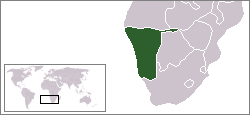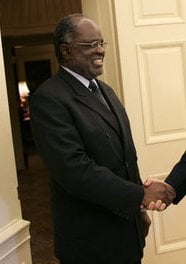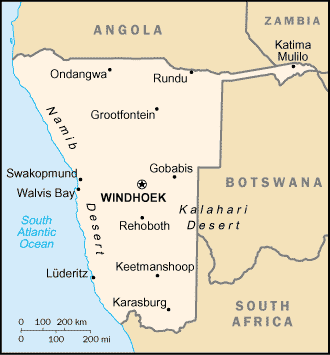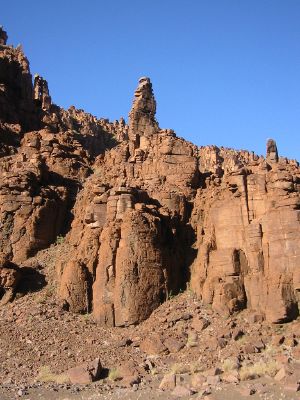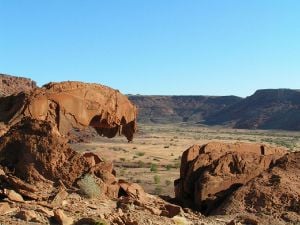Namibia
| Republic of Namibia | ||||||
|---|---|---|---|---|---|---|
|
||||||
| Motto: Unity, Liberty, Justice | ||||||
| Anthem: Namibia, Land of the Brave |
||||||
| Capital (and largest city) | Windhoek 22°33′S 17°15′E | |||||
| Official languages | English1 | |||||
| Government | Republic | |||||
| - | President | Hifikepunye Pohamba | ||||
| - | Prime minister | Nahas Angula | ||||
| Independence | From South Africa | |||||
| - | Date | March 21, 1990 | ||||
| Area | ||||||
| - | Total | 825,418 km² (33rd) 318,696 sq mi |
||||
| - | Water (%) | Negligible | ||||
| Population | ||||||
| - | July 2005 estimate | 2,031,0002 (144th) | ||||
| - | 2002 census | 1,820,916 | ||||
| GDP (PPP) | 2005 estimate | |||||
| - | Total | $15.78 billion (123rd) | ||||
| - | Per capita | $7,800 (88th) | ||||
| Currency | Namibian dollar (NAD) |
|||||
| Time zone | (UTC+1) | |||||
| Internet TLD | .na | |||||
| Calling code | +264 | |||||
| 1) German and Afrikaans were official languages until independence in 1990. The majority of the population speaks Afrikaans as a second language, while Oshiwambo is the first language of half the population. German is spoken by 32% of the European community whereas English is only spoken by 7%. 2) Note: estimates for this country explicitly take into account the effects of excess mortality due to AIDS; this can result in lower life expectancy, higher infant mortality and death rates, lower population and growth rates, and changes in the distribution of population by age and sex than would otherwise be expected. |
||||||
Namibia, officially the Republic of Namibia, is a sparsely populated country in southern Africa on the Atlantic coast. It gained independence from South Africa in 1990 after a protracted war for independence led by the South West Africa People's Organization (SWAPO). Namibia has made great progress since independence, but it faces two formidable challenges: controlling one of the world's worst AIDS epidemics (affecting about one-quarter of the population) and correcting the world's worst income disparity. Though it is rich in mineral wealth, including diamonds and uranium, about 70 percent of the population depends on subsistence agriculture. The country's political institutions are still dominated by SWAPO, whose leader became the first president. His hand-picked successor took office in 2005, vowing to implement land reforms.
History
The dry lands of Namibia were inhabited since early times by Bushmen, Damara, Namaqua, and since about the fourteenth century C.E., by immigrating Bantu who came with the Bantu expansion. The region was not extensively explored by Europeans until the nineteenth century, when the land came under German control as South-West Africa — apart from Walvis Bay under British control. South Africa occupied until after World War II, when it unilaterally annexed the territory, albeit without international recognition.
In 1966 the Marxist South-West Africa People's Organisation (SWAPO) guerrilla group launched a war of independence, but it was not until 1988 that South Africa agreed to end its administration of Namibia, in accordance with a United Nations peace plan for the entire region. Independence came in 1990, and Walvis Bay was ceded to Namibia in 1994.
Politics
The Namibian head of state is the president, elected by popular vote every five years. The government is headed by the prime minister, who, together with his cabinet, is appointed by the president. SWAPO, the primary force behind independence, is still currently the country's largest party.
Namibia's bicameral parliament consists of the National Council with twenty-six seats, occupied by two members chosen from each regional council to serve six-year terms; and the National Assembly of seventy-eight seats, of which seventy-two are elected by popular vote and six non-voting members are appointed by the president. All seventy-eight serve five-year terms.
The Assembly is the primary legislative body, with the Council playing more of an advisory role. The 1990 constitution is noted for being one of the first to incorporate protection of the environment into its text. The highest judicial body is the Supreme Court, whose judges are appointed by the president on the recommendation of the Judicial Service Commission.
Administrative Divisions
Main articles: Regions of Namibia, Constituencies of Namibia
Namibia is divided into thirteen regions and subdivided into 102 constituencies.
Geography
- Main articles: Geography of Namibia, Towns in Namibia
It is bordered by Angola, and Zambia to the north, Botswana to the east, and South Africa to the south.
The Namibian landscape consists primarily of central highlands, of which the highest point is the Brandberg at (8,550 ft) (2,606 meters). The central plateau runs from north to south, bordered by the Namib Desert and its coastal plains to the west, the Orange River to the south, and the Kalahari Desert to the east. In the south, the grandeur of the Fish River Canyon, which reaches a maxmum depth of XXX (550 meters), is said to be second only to the Grand Canyon in the United States.
A narrow piece of land in the northeast, known as the Caprivi Strip, is the vestige of a corridor granted to Germany so it could have access to the Zambezi River.
The Namibian climate ranges from desert to subtropical, and is generally hot and dry; precipitation is sparse and erratic. The cold, north-flowing Benguela current accounts for some of the low precipitation. Besides the capital city Windhoek in the center of the country, other important towns are the ports of Walvis Bay and Swakopmund, as well as Oshakati, Grootfontein, Tsumeb, and Keetmanshoop.
Economy
The economy is heavily dependent on the extraction and processing of minerals for export. Mining accounts for 20 percent of the GDP. Namibia is the fourth largest exporter of non-fuel minerals in Africa, and the world's fifth largest producer of uranium. Rich alluvial diamond deposits make Namibia a primary source for gem-quality diamonds. Namibia also produces large quantities of [[copper], lead, zinc, and several other minerals. Natural gas was discovered offshore, but the field remains undeveloped.
More than half the population depends on agriculture (largely subsistence agriculture) for its livelihood. Namibia must import some of its food. Although per capita GDP is five times the per capita GDP of Africa's poorest countries, the majority of Namibia's people live in pronounced poverty because of large-scale unemployment, the great inequality of income distribution, and the large amount of wealth going to foreigners. The Namibian economy has many close links to South Africa. Agreement has been reached on the privatization of several more enterprises in coming years, which should stimulate long-run foreign investment.
Namibia attracts a number of eco-tourists, with the majority visiting to experience the different climates and natural geographical landscapes such as the great eastern desert and plains. There are many lodges and reserves for eco-tourists.
Demographics
Namibia is among the three countries with the lowest population density. The majority of the Namibian population are African (Bantu and Khoisan), mostly of the Ovambo tribe, which forms about half of the population, concentrated in the north of the country. In addition to the black Bantu majority, there are large groups of Khoisan (e.g., Nama and Bushmen), who are descendants of the original inhabitants of Southern Africa. Khoisan differ significantly in appearance from both Bantu and whites. There are also two smaller groups of people with mixed racial origins, called "Coloreds" and "Basters", who together make up 8 percent (with the Coloreds outnumbering the Basters two to one). Whites of Dutch, German, British, French and Portuguese ancestry make up about 8 percent of the population—which is the second largest proportion in sub-Saharan Africa, after South Africa). Most Namibian whites and nearly all those of mixed race are Afrikaans speakers and share similar origins, culture, religion and genealogy with the white and colored populations of neighboring South Africa. A smaller proportion of whites (around twenty thousand) trace their family origins directly back to German settlers and maintain German cultural and educational institutions. All Portuguese are white miners and settlers from their former colony of Angola.
Half of all Namibians speak Oshiwambo (Ovambo) as their first language, whereas the most widely understood language is Afrikaans. Among the younger generation, the most widely understood language is English. Both Afrikaans and English are used primarily as a second language reserved for public communication, but small first language groups exist throughout the country. While the official language is English, most of the white population speaks either Afrikaans or German, both official languages until 1990, when Namibia became independent. Portuguese is spoken by blacks and whites from Angola.
Christianity is the major religion, with the Lutheran Church being the largest.
Miscellaneous topics
- Communications in Namibia
- Constituencies of Namibia
- Foreign relations of Namibia
- Frankie Fredericks
- List of cities in Namibia
- List of Namibian companies
- List of Namibians
- National parks
- Military of Namibia
- Rugby union in Namibia
- Namibia national rugby union team
- Namibia Breweries Limited
- Namibian cricket team
- Regions of Namibia
- Reporters without borders Worldwide Press Freedom Index 2003: Rank 56 out of 166 countries (3-way tie) (31 out of 139 countries - 2002)
- Transport in Namibia
- Scouts of Namibia
External links
Government
- Republic of Namibia - Namibian Governmental Portal
- http://www.orusovo.com/namcon/ Constitution of the Republic of Namibia
News
- Allgemeine Zeitung Namibia - (in German)
- The Namibian - (in English)
- NewEra.com - (in English)
- Die Republikein - (in Afrikaans)
Overviews
- BBC News - Country Profile: Namibia
- CIA World Factbook - Namibia
- Open Directory Project - Namibia directory category
- US State Department - Namibia includes Background Notes, Country Study and major reports
Tourism
- Namibia - The Ultimate African Safari
- Travel guide to Namibia from Wikitravel
- 2 WebCams showing Windhoek and weather in central Namibia
Other
- Goethe Institut Windhoek (in German)
- Namibian Broadcasting Corporation - National TV and radio service
- Desert Research Foundation of Namibia - Environmental and development NGO based in Windhoek
- Gobabeb Training & Research Centre - Centre for ecological and development research and training in the Namib-Naukluft Park
- Namibian History - History of Namibia
- University of Namibia - National University
- "Namibia's Mobile Sculptures", from Awake! magazine (March 8, 2001)
Sovereign states
Algeria ·
Angola ·
Benin ·
Botswana ·
Burkina Faso ·
Burundi ·
Cameroon ·
Cape Verde ·
Central African Republic ·
Chad ·
Democratic Republic of the Congo ·
Republic of the Congo ·
Comoros ·
Côte d'Ivoire ·
Djibouti ·
Egypt1 ·
Equatorial Guinea ·
Eritrea ·
Ethiopia ·
Gabon ·
The Gambia ·
Ghana ·
Guinea-Bissau ·
Guinea ·
Kenya ·
Lesotho ·
Liberia ·
Libya ·
Madagascar ·
Malawi ·
Mali ·
Mauritania ·
Mauritius ·
Morocco ·
Mozambique ·
Namibia ·
Niger ·
Nigeria ·
Rwanda ·
Senegal ·
Seychelles ·
Sierra Leone ·
Somalia ·
South Africa ·
Spain2 ·
Sudan ·
Swaziland ·
São Tomé and Príncipe ·
Tanzania ·
Togo ·
Tunisia ·
Uganda ·
Zambia ·
Zimbabwe
Dependencies | Unrecognized
British Indian Ocean Territory (UK) ·
French Southern and Antarctic Lands (France) ·
Mayotte (France) ·
Réunion (France) ·
St. Helena3 (UK)
|
Puntland ·
Somaliland ·
Sahrawi Arab Democratic Republic
1 Partly in Asia. 2 Mostly in Europe. 3 Includes the dependencies of Ascension Island and Tristan da Cunha.
Credits
New World Encyclopedia writers and editors rewrote and completed the Wikipedia article in accordance with New World Encyclopedia standards. This article abides by terms of the Creative Commons CC-by-sa 3.0 License (CC-by-sa), which may be used and disseminated with proper attribution. Credit is due under the terms of this license that can reference both the New World Encyclopedia contributors and the selfless volunteer contributors of the Wikimedia Foundation. To cite this article click here for a list of acceptable citing formats.The history of earlier contributions by wikipedians is accessible to researchers here:
The history of this article since it was imported to New World Encyclopedia:
Note: Some restrictions may apply to use of individual images which are separately licensed.


